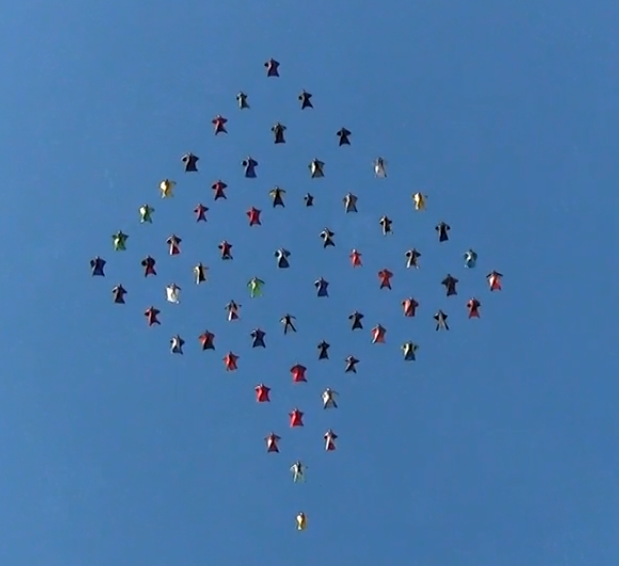Recommended Posts
dthames 0
I have not specifically tried to be big instead of tight. It seems hard to imaging good glide ratio numbers with my arms sticking out and going slow(er). Maybe I need to give that some time as well.
Testing "inline" image
[inline
90-deg.jpg]
rehmwa 2
QuoteI have not specifically tried to be big instead of tight. It seems hard to imaging good glide ratio numbers with my arms sticking out and going slow(er). Maybe I need to give that some time as well.
...
Driving is a one dimensional activity - a monkey can do it - being proud of your driving abilities is like being proud of being able to put on pants
hillson 0
dthames 0
Quotewhat are we seeing in that picture?
That is a snapshot of a Google Earth representation of a solo tracking dive presented from Flysight GPS data. I have attached the Goggle Earth file. You have to install Google Earth first, if you want to use the file.
In the image the red line is the path on the last part of the dive where the glide ratio was best. While pretty good, certainly not "flat" in any way. (haha)
kallend 2,034
QuoteTwo schools of thought on tracking:
1. OLD SCHOOL. This was the common method that was taught for years. Turn face out and accelerate as fast as possible, more of a delta body position, turning into a dearch body position as you accellerate, gets you going faster quicker.
2. NEW SCHOOL. Get big, de-arch as you make your turn, then legs out but keeping your hands/arms more forward/down, doesn't seem to get you moving as quick, but allows for more time tracking (slower fall rate) which in the end allows you to go futher horizontally in the same amount of altitude loss.
The newer method is refered to as flat track rather than just track.
I use the "old" method and have yet to be out-tracked (horizontal distance covered) on breakoff by anyone using the "new" method. I think the "new" method is just a crutch for those who are basically poor trackers.
The only sure way to survive a canopy collision is not to have one.
sundevil777 102
QuoteQuoteTwo schools of thought on tracking:
1. OLD SCHOOL. This was the common method that was taught for years. Turn face out and accelerate as fast as possible, more of a delta body position, turning into a dearch body position as you accellerate, gets you going faster quicker.
2. NEW SCHOOL. Get big, de-arch as you make your turn, then legs out but keeping your hands/arms more forward/down, doesn't seem to get you moving as quick, but allows for more time tracking (slower fall rate) which in the end allows you to go futher horizontally in the same amount of altitude loss.
The newer method is refered to as flat track rather than just track.
I use the "old" method and have yet to be out-tracked (horizontal distance covered) on breakoff by anyone using the "new" method. I think the "new" method is just a crutch for those who are basically poor trackers.
On this we agree. Using the old method can get attention by some organizers when they see a large body to horizon angle initially, even though a person does not fall away (as they would if doing a simply lousy dive away type track). The "new" method, I think just results in a slow horizontal acceleration that is not at all compensated by a slower vertical speed.
pchapman 279
I tend to be on the side of Sundevil and Kallend, in that parts of the Old School idea are correct, even if some may be wrong. It all depends on what one defines as "old school tracking"...
It is TOO old school if someone "dives for speed", intending to pull out flatter later. And doing "more of a delta" will also be wrong. But trying to accelerate horizontally quickly is good (within the limits of any tracking teams). With the limited time available, you want to be getting to a high speed track quickly to maximize distance.
A moderately steep body angle early on will achieve a faster acceleration and an overall benefit, with very little altitude loss at the start. (Because if there is an ideal angle of attack, the body angle must be steeper at the start when the airflow is from directly below.) It is still be useful to get big during the turn (= new school). There's little downside to that as long as everyone is slowing down to a similar degree.
JohnMitchell 16
Like I say "Hit it hard, hit it fast."Quote
But trying to accelerate horizontally quickly is good (within the limits of any tracking teams). With the limited time available, you want to be getting to a high speed track quickly to maximize distance.
The other day we had a 12 way that had disintegrated to chaos by breakoff. A very petite woman jumper, Vskydiver's size, said she looked above herself, saw me overhead and thought "Uh-oh, traffic." She said then I hit my track and flew up and away, out of the picture. Nothing like a really good track to get yourself out of a hot spot.
kallend 2,034
QuoteLike I say "Hit it hard, hit it fast."Quote
But trying to accelerate horizontally quickly is good (within the limits of any tracking teams). With the limited time available, you want to be getting to a high speed track quickly to maximize distance.
The other day we had a 12 way that had disintegrated to chaos by breakoff. A very petite woman jumper, Vskydiver's size, said she looked above herself, saw me overhead and thought "Uh-oh, traffic." She said then I hit my track and flew up and away, out of the picture. Nothing like a really good track to get yourself out of a hot spot.
Yep! Forward speed is what gives you lift. The sooner you build up forward speed the more lift you generate and in turn lift is what provides forward drive. All the slow, "get big" turn does is increase drag while providing no forward drive.
The only sure way to survive a canopy collision is not to have one.
dthames 0
QuoteQuoteLike I say "Hit it hard, hit it fast."Quote
But trying to accelerate horizontally quickly is good (within the limits of any tracking teams). With the limited time available, you want to be getting to a high speed track quickly to maximize distance.
The other day we had a 12 way that had disintegrated to chaos by breakoff. A very petite woman jumper, Vskydiver's size, said she looked above herself, saw me overhead and thought "Uh-oh, traffic." She said then I hit my track and flew up and away, out of the picture. Nothing like a really good track to get yourself out of a hot spot.
Yep! Forward speed is what gives you lift. The sooner you build up forward speed the more lift you generate and in turn lift is what provides forward drive. All the slow, "get big" turn does is increase drag while providing no forward drive.
I aggressively change my angle of attach right away. That is not to “dive for speed” but to get a force acting to get some horizontal speed up. That seems to work well and the horz speed ramps up at almost a constant rate for several seconds.
billvon 3,009
Yes. And this is EXACTLY what you should be doing as you turn away from any large formation. You start by getting as big as possible as you undock; this prevents you from dropping below the formation. As you turn past the 90 degree mark you start transitioning into a slow track position (legs come down) and then as you hit 180 you transition into a fast track position (shoulders come down, belly comes up.) This allows very fast tracking without dropping below the formation. A good tracking wave will track up and away from the formation, thus giving the outermost people the maximum time to track and the best visibility.








.thumb.jpg.4bb795e2eaf21b8b300039a5e1ec7f92.jpg)
Mmmm, I say that there is a "best" lift-to-drag ratio or glide ratio for each person. If you're on that glide path at your most efficient angle of attack, your airspeed (and forward speed and downward speed) will stabilize at what is right for your weight. I think in aircraft it's called Vy, or best rate of climb or glide speed. Go above or below that speed and your glide ratio drops; you become less efficient.
Share this post
Link to post
Share on other sites